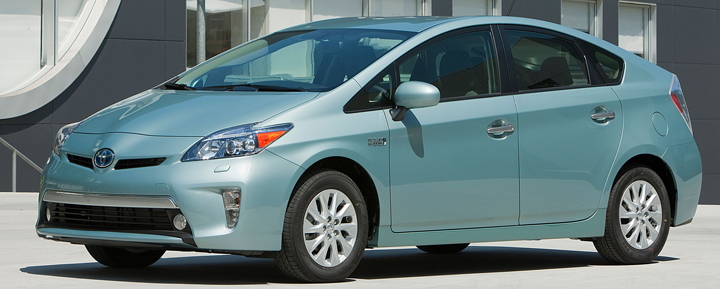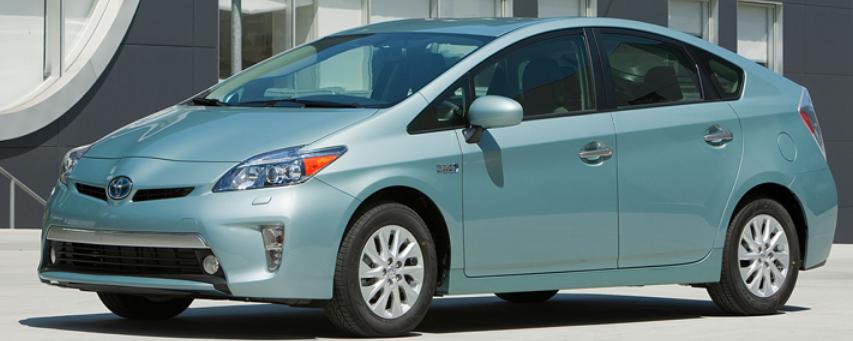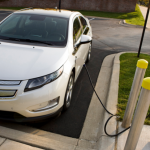
I recently spent a week with a 2012 Toyota Prius Plug-In Hybrid—a.k.a. Prius PHV—and logged no less than 90.1 mpg. That’s a sensational figure, but as Lucy Ricardo’s husband would say, it needs some “’splainin’.”
Test Drive: 2017 Cadillac CT6 Plug-In
Plug-In Hybrid MPG
The long-promised Plug-In is one of three new Prius models for 2012. It’s basically the familiar domed-roof hatchback fitted with a 4.4 kWh lithium-ion battery pack instead of a 1.3 kWh nickel-metal-hydride array. It also has an upgraded battery-cooling system, as Li-Ion cells are more temperature-sensitive than NiMH. Exterior differences are confined to special badges and a plug-in port on the right-rear fender, which matches the normal fuel-filler on the left flank. The PHV also adds several standard features above those on the regular entry-level Prius II. These include voice-activated navigation, a rearview camera, heated seats and mirrors, satellite radio, and Toyota’s Entune infotainment controller.
Li-Ion batteries are still pretty pricey, so the PHV is too. The base version starts at $32,000, a hefty $2,195 more than the top-trim cordless Prius V. Our tester was the Advanced model that comes with a pre-collision system, Toyota’s Safety Connect assistance, a power driver seat, adaptive cruise control, a head-up display, JBL speakers, LED headlamps, and more. It opens at $39,525, which is very close to the starting price on a 2012 Chevrolet Volt.
Tellingly, however, the Volt qualifies for a maximum $7,500 federal tax credit, while the PHV merits only $2,500. And where the plug-in Chevy can go some 30-40 miles on volts alone, the PHV does just 12-15 miles in its electric-only EV mode. (Other Prii also have EV mode, but can run only 1-3 miles because their smaller batteries store much less energy.) On the other hand, the Toyota’s battery can be recharged from a 120-volt household plug in 2-3 hours, versus 10 hours for the Volt’s 16 kWh array. And while the Toyota can be driven like a regular hybrid or as an electric (so long as the battery has sufficient juice), a fully charged Volt always starts in electric mode. Its gas engine won’t kick in until the battery runs down to a pre-determined point. By contrast, the PHV’s gas engine fires up when needed to match power demands, even in EV mode.
The EPA rates the standard Prius hatchback at 51/48 mpg for city/highway driving and 50 mpg combined. The Plug-In rates 51/49 mpg city/highway, 50 combined on “regular gas only,” and 95 mpg-e in EV mode. The Volt rates 37 mpg combined on its range-extender engine’s required premium-grade gasoline and 94 mpg-e on pure electric. Interestingly, the gummint pegs total driving range at 540 miles for the Prius PHV, 380 for the Volt.
OK, fine, but you probably want to know how we managed that eye-opening 90.1 mpg. Shucks, it was easy. As things worked out, more than half of our miles involved low-speed, close-to-home errand-running, exactly the kind of driving the PHV’s super-size battery pack is designed for. And though 12 miles doesn’t sound like much, it was more than enough range for our shopping trips. In fact, we suspect EV mode by itself would be perfectly adequate for the daily driving needs of many suburbanites and inner-city dwellers. For various reasons, we did little commuter-type freeway work or other driving that required the gas engine. Otherwise, we’d have averaged more like 60 mpg, perhaps even closer to the 47.0 mpg logged by my Chicago-based colleagues in frigid weather.
It bears mentioning that unlike the Volt, the PHV doesn’t have to be plugged in at every opportunity. That’s because the drive system reverts from EV mode to conventional hybrid operation once the battery runs too low to provide sufficient power on its own. In that event, the gas engine fires and the battery recharges during braking and coasting, just like a normal Prius and many other hybrids.
So should you buy a Prius Plug-In? That depends. For one thing, the PHV is quite expensive for a Prius, even allowing for its extra standard stuff. And despite our fantastic mileage number, the PHV is little more real-world thrifty than a normal Prius and other compact hybrid cars. Then too, it drives pretty much like the plain old Prius hatchback, so it’s comfortable and reasonably quiet, but boring. Quick direction changes are far from sporty, and 0-60 mph takes a leisurely 11 seconds or so. Moreover, the ride turns brittle on patchy pavement.
But the main argument against the PHV is that there’s little reason to choose it over a conventional hybrid as long as gas remains relatively cheap (below, say, $4.50 a gallon). Also, this isn’t the only reasonably priced plug-in around. The Volt is already on sale, of course, but others are coming (like Ford’s new C-Max Energi) that may be better bets for refinement, performance, utility, and value. And don’t forget that if spending less on gas is all you’re after, there are many conventional cars that deliver near-hybrid economy for much less outlay.
The bottom line? The regular Prius is the world’s best selling hybrid car, and the PHV enhances that appealing package with the ability to go faster and further on battery power alone. It also one-ups the Volt by allowing the driver to decide when and how to use electric mode. If all that appeals to you, go for it. Just understand that the Prius Plug-In is no less a compromise than any other hybrid, even if you might coax 90 mpg out of it.
I Broke the 50-MPG Barrier Driving Through Wisconsin. It was Hell.



